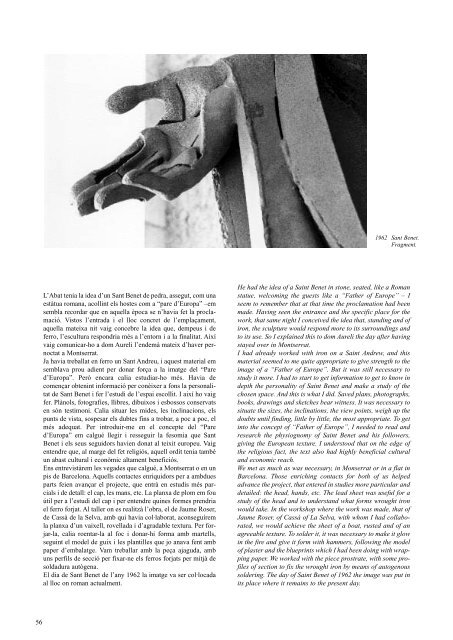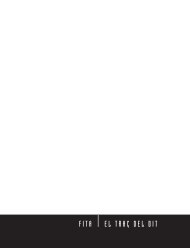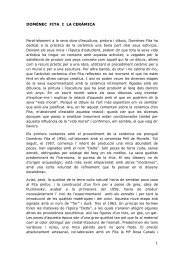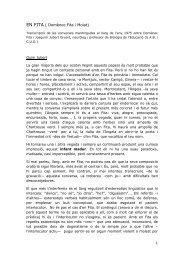Fita ART INTEGRAT, 2005. - Fundació Fita
Fita ART INTEGRAT, 2005. - Fundació Fita
Fita ART INTEGRAT, 2005. - Fundació Fita
You also want an ePaper? Increase the reach of your titles
YUMPU automatically turns print PDFs into web optimized ePapers that Google loves.
56<br />
L’Abat tenia la idea d’un Sant Benet de pedra, assegut, com una<br />
estàtua romana, acollint els hostes com a “pare d’Europa” –em<br />
sembla recordar que en aquella època se n’havia fet la proclamació.<br />
Vistos l’entrada i el lloc concret de l’emplaçament,<br />
aquella mateixa nit vaig concebre la idea que, dempeus i de<br />
ferro, l’escultura respondria més a l’entorn i a la finalitat. Així<br />
vaig comunicar-ho a dom Aureli l’endemà mateix d’haver pernoctat<br />
a Montserrat.<br />
Ja havia treballat en ferro un Sant Andreu, i aquest material em<br />
semblava prou adient per donar força a la imatge del “Pare<br />
d’Europa”. Però encara calia estudiar-ho més. Havia de<br />
començar obtenint informació per conèixer a fons la personalitat<br />
de Sant Benet i fer l’estudi de l’espai escollit. I així ho vaig<br />
fer. Plànols, fotografies, llibres, dibuixos i esbossos conservats<br />
en són testimoni. Calia situar les mides, les inclinacions, els<br />
punts de vista, sospesar els dubtes fins a trobar, a poc a poc, el<br />
més adequat. Per introduir-me en el concepte del “Pare<br />
d’Europa” em calgué llegir i resseguir la fesomia que Sant<br />
Benet i els seus seguidors havien donat al teixit europeu. Vaig<br />
entendre que, al marge del fet religiós, aquell ordit tenia també<br />
un abast cultural i econòmic altament beneficiós.<br />
Ens entrevistàrem les vegades que calgué, a Montserrat o en un<br />
pis de Barcelona. Aquells contactes enriquidors per a ambdues<br />
parts feien avançar el projecte, que entrà en estudis més parcials<br />
i de detall: el cap, les mans, etc. La planxa de plom em fou<br />
útil per a l’estudi del cap i per entendre quines formes prendria<br />
el ferro forjat. Al taller on es realitzà l’obra, el de Jaume Roser,<br />
de Cassà de la Selva, amb qui havia col·laborat, aconseguírem<br />
la planxa d’un vaixell, rovellada i d’agradable textura. Per forjar-la,<br />
calia roentar-la al foc i donar-hi forma amb martells,<br />
seguint el model de guix i les plantilles que jo anava fent amb<br />
paper d’embalatge. Vam treballar amb la peça ajaguda, amb<br />
uns perfils de secció per fixar-ne els ferros forjats per mitjà de<br />
soldadura autògena.<br />
El dia de Sant Benet de l’any 1962 la imatge va ser col·locada<br />
al lloc on roman actualment.<br />
1962 Sant Benet.<br />
Fragment.<br />
He had the idea of a Saint Benet in stone, seated, like a Roman<br />
statue, welcoming the guests like a “Father of Europe” – I<br />
seem to remember that at that time the proclamation had been<br />
made. Having seen the entrance and the specific place for the<br />
work, that same night I conceived the idea that, standing and of<br />
iron, the sculpture would respond more to its surroundings and<br />
to its use. So I explained this to dom Aureli the day after having<br />
stayed over in Montserrat.<br />
I had already worked with iron on a Saint Andrew, and this<br />
material seemed to me quite appropriate to give strength to the<br />
image of a “Father of Europe”. But it was still necessary to<br />
study it more. I had to start to get information to get to know in<br />
depth the personality of Saint Benet and make a study of the<br />
chosen space. And this is what I did. Saved plans, photographs,<br />
books, drawings and sketches bear witness. It was necessary to<br />
situate the sizes, the inclinations, the view points, weigh up the<br />
doubts until finding, little by little, the most appropriate. To get<br />
into the concept of “Father of Europe”, I needed to read and<br />
research the physiognomy of Saint Benet and his followers,<br />
giving the European texture. I understood that on the edge of<br />
the religious fact, the text also had highly beneficial cultural<br />
and economic reach.<br />
We met as much as was necessary, in Monserrat or in a flat in<br />
Barcelona. Those enriching contacts for both of us helped<br />
advance the project, that entered in studies more particular and<br />
detailed: the head, hands, etc. The lead sheet was useful for a<br />
study of the head and to understand what forms wrought iron<br />
would take. In the workshop where the work was made, that of<br />
Jaume Roser, of Cassà of La Selva, with whom I had collaborated,<br />
we would achieve the sheet of a boat, rusted and of an<br />
agreeable texture. To solder it, it was necessary to make it glow<br />
in the fire and give it form with hammers, following the model<br />
of plaster and the blueprints which I had been doing with wrapping<br />
paper. We worked with the piece prostrate, with some profiles<br />
of section to fix the wrought iron by means of autogenous<br />
soldering. The day of Saint Benet of 1962 the image was put in<br />
its place where it remains to the present day.








